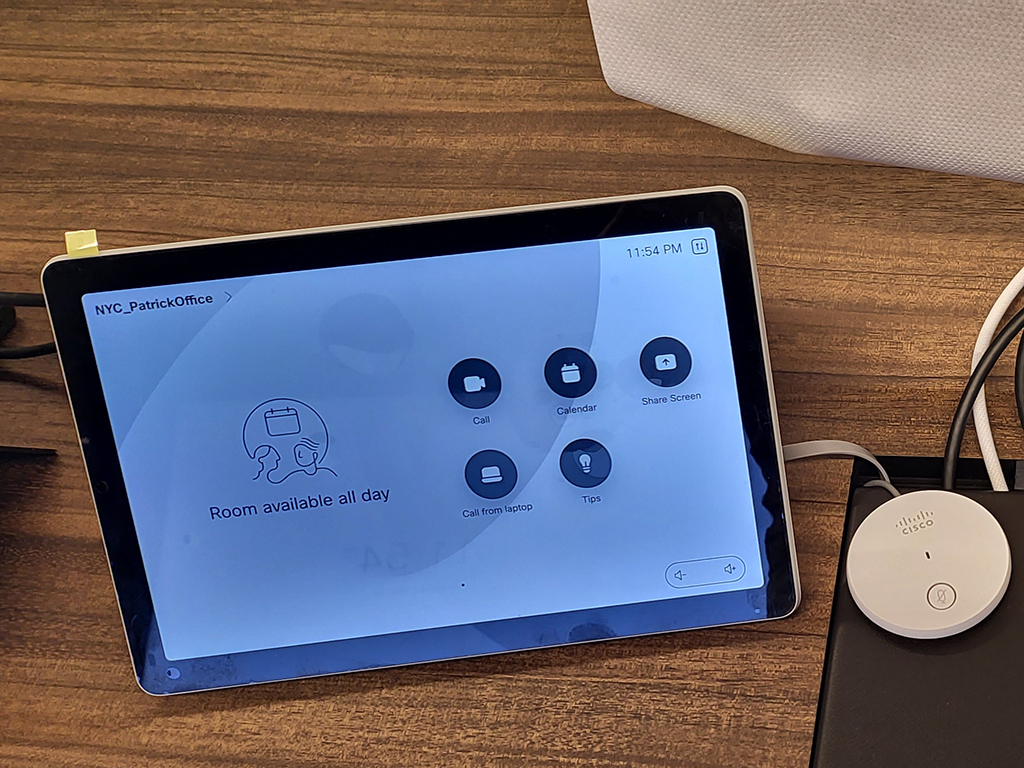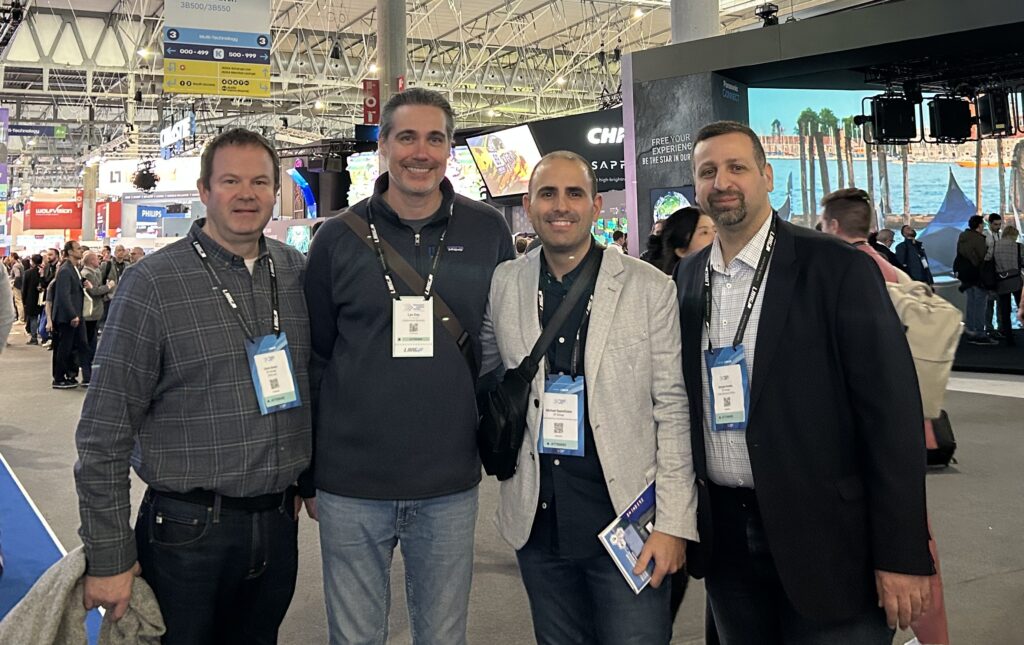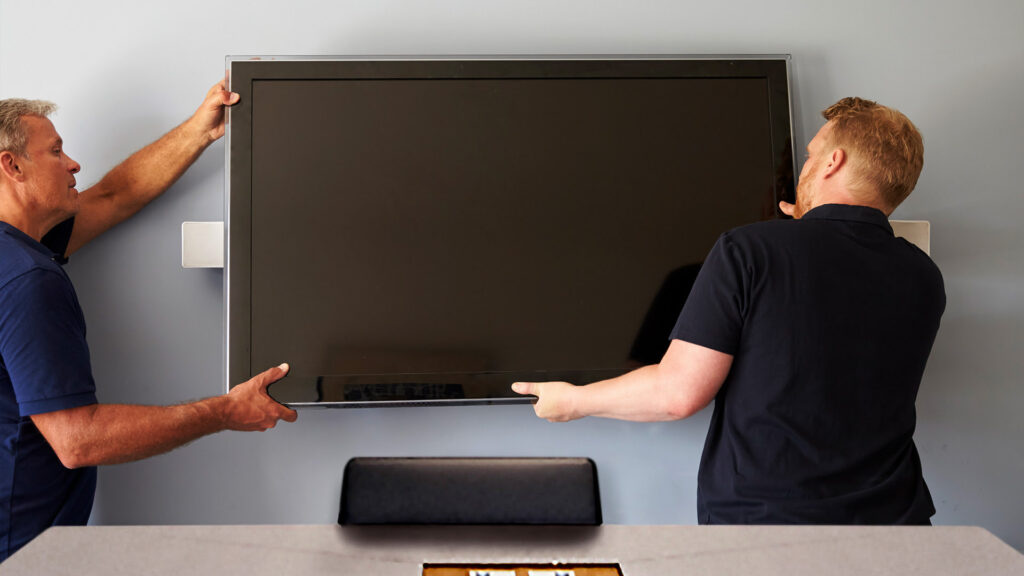Different Approaches to One Touch Join: Pexip, Synergy SKY, & More
Summary:
- One-touch join (OTJ) features streamline the meeting process by giving on-site workers the ability to join meetings hosted anywhere without manually entering any data. This reduces friction and makes it easier to connect with remote workers.
- With the right configuration, OTJ can help bridge the gap between dedicated meeting hardware and platforms like Zoom, Teams, or Google Meet. This software-based service works in the background to provide platform-agnostic interoperability.
- Vendors like Cisco, Pexip, Poly, and Synergy SKY all approach one-touch join in a slightly different way. Seemingly minor differences like support for legacy devices or broad compatibility with outside platforms can make a big difference for end users.
- Deploying solutions like one-touch join requires careful planning and constant evaluation over time. It’s important to consider what people need and what problem the solution is trying to solve.
- Future trends like AI-driven scheduling, real-time translations, and advanced integration will change the meeting experience for the better. One day, joining a meeting could become as easy as speaking the right words out loud.
As a concept, one-touch join is about simplifying the meeting process. People working on-site can walk into a room, click a button, and instantly connect with clients, customers, and colleagues who aren’t physically present via Zoom, Google Meet, and Teams.
Nearly all providers use software to power one-touch join silently behind the scenes, but most take their own approach to the feature. Understanding these differences can help you compare the available options to determine which is best for your organization’s needs.
ET Group specializes in custom workplace technology solutions that help companies make the most of one-touch join in hybrid environments. Learn how Pexip, Synergy SKY, and other providers approach one-touch join, then contact us to find the right fit.
Related: The Best Apps for Virtual Team Meetings

Why One-Touch Join Matters for Hybrid Teams
Remote workers rarely have access to room appliances and other dedicated hardware from home. Instead, they usually work from their own smartphones, tablets, and computers. Most of these devices are platform-agnostic, which means they’re compatible with services like Zoom, Google Meet, and Microsoft Teams out of the box.
If your dedicated meeting hardware doesn’t support connections to external third-party platforms, you now have a problem. People working in the office need to find workarounds or follow a long list of manual steps every time they want to connect—and that can stifle collaboration.
One-touch join can help address pain points like these invisibly behind the scenes, but only if you have the right solution in place. Here’s how each of the top four providers stack up.
Comparing Pexip, Synergy SKY, & Other Solutions
Hybrid teams thrive when they can seamlessly connect, collaborate, and even socialize from any location with zero stress. Providers like HP Poly, Pexip, Synergy SKY, and Cisco all use software to support this need by giving people the option to connect in as little as one click.
The core idea of being able to tap a button and connect to a meeting hosted on any platform isn’t new, and stays fairly consistent across most brands. What varies is the approach each provider takes to one-touch join and how they refer to it in documentation.
| Provider | Feature Name | Key Strength | Best For | Unique Feature | Limitations |
| Cisco | One Button to Push (OBTP) | Reliable integration for legacy systems | Organizations with older SIP/H.323 hardware or existing Cisco setups | Makes older hardware compatible with modern platforms | Best suited for Cisco environments |
| Pexip | One Touch Join (OTJ) | Highly adaptable to different setups | Businesses with complex or custom meeting room configurations | Works with diverse platforms and unique meeting needs | Requires technical expertise for configuration |
| HP Poly | One Touch Dial (OTD) | Strong hardware compatibility | Organizations using Poly hardware for multi-platform support | Simplifies joining meetings across supported platforms | Limited to compatible Poly devices |
| Synergy SKY | CONNECT | Unified calendar and platform management | Teams juggling multiple calendars or platforms | Combines scheduling and OTJ functionality in one system | Best for organizations using multiple platforms like Cisco and Zoom |
Unique Features and Benefits of Each Provider’s Approach
To choose the right OTJ technology, you need to understand if and how each vendor’s offerings align with your team’s needs. Partnering with a company like ET Group can help you explore your options and save money on testing and iteration, but here’s a quick overview of the most apparent differences.
Cisco WebEx (OBTP)
If you’re already working with Cisco hardware or legacy SIP/H.323 devices, OBTP may be the easiest and most accessible option for you. It’s specifically tailored to work in environments like these and comes with support for WebEx tools right out of the box.
- What Makes Cisco Different? Cisco is primarily focused on extending the usability of legacy hardware and their own branded devices without overcomplicating the process. In some cases, this can help organizations delay or avoid costly updates until they’re ready.
- Why Choose Cisco’s OBTP? OBTP is the ideal solution for teams who are already familiar with Cisco systems. There’s no steep learning curve or extensive retraining required because most of the core functionality is exactly the same—even if teams work with a mix of old and new devices.
Cisco’s brand-specific approach can also be a double-edged sword. Features like OBTP may not work as well—or at all—with third-party devices.
Pexip (OTJ)
For teams that work across multiple platforms, like Zoom, Teams, and Google Meet, Pexip’s OTJ has a lot to offer. It’s specifically designed to support flexibility and ease of use in environments where meeting tech needs to stay flexible to support a wide range of needs.
- What Makes Pexip OTJ Different? The fact that Pexip doesn’t marry itself to a single platform or environment makes it uniquely well-suited to the modern hybrid workplace. Organizations can deploy it as a licensing option with self-hosted Pexip Infinity, as part of a Pexip Connect bundle, or as a completely standalone solution.
- Why Choose Pexip’s OTJ? Pexip’s partnership with Poly means they support Poly VTC hardware right out of the box. OTJ is also compatible with Cisco room appliances, which may be ideal for organizations who are slowly upgrading or working with a mix of equipment.
Pexip OTJ can unfortunately be very technically complex to deploy and manage over time. You’ll need an in-house or external IT team who can provide support if you choose this option. ET Group can help ease this pain point with remote or on-site support.
HP Poly (OTD)
Poly’s OTD is a cloud-based service that provides direct interoperability between most Poly devices and a limited number of Cisco room appliances. It is specifically designed to integrate with Microsoft Exchange and Google Calendar, the two most commonly used calendar systems on the market.
- What Makes HP Poly’s OTD Different? A cloud-hosted option means there’s no need to roll out or deploy your or own solution on-site. Plus, Poly has already started to integrate Pexip technology into some devices as a result of their partnership.
- Why Choose Poly OTD? It’s simple to use and manage if your organization is already working with Poly Studio X, Trio, Group Series, and/or certain Cisco room appliances. You can login and manage the service from anywhere on Poly’s website.
Poly’s OTD is only compatible with Exchange 2010-2019 on-premise editions, Office 365 Exchange online, and Google calendaring. If you’re using a different solution, it won’t work for your needs.
Synergy SKY (CONNECT)
Synergy SKY’s CONNECT combines single-tap join functionality with a full suite of tools for unified communication. This all-on-one approach makes it possible to use as a standalone solution, or as a part of a larger pre-existing environment.
- What Makes Synergy SKY’s One-Click Different? Synergy’s deep focus on unified communications helps address some of the most common pain points. It can be configured to work with many different devices and platforms, including Zoom and Microsoft Teams.
- Why Choose Synergy SKY CONNECT? It’s an ideal solution for organizations that need to manage communications across multiple platforms or calendars. It has special features that make sharing content both ways easier.
Synergy SKY CONNECT’s main drawback tends to pricing—it’s slightly more expensive than some other solutions on the market.
Related: 5 Common Problems Solved by Using the Right Hybrid Meeting Equipment & Training

Integration Capabilities with Different Meeting Platforms
Cisco, Pexip, Poly, and Synergy all support one-touch join features, but they don’t necessarily all facilitate connections to the same meeting platforms. In fact, the difference between each provider is so distinct, choosing the wrong option could lock you out of some platforms completely.
- Cisco’s OBTP fully supports WebEx, Microsoft Teams, and Google Meet. Integration with Zoom is also possible via the WebEx Hybrid Calendar service.
- Pexip’s OTJ is compatible with the widest array of platforms. It can be integrated with Microsoft Teams, WebEx, Zoom, Google Meet, Skype for Business, GoToMeeting, and BlueJeans.
- HP Poly’s OTD works seamlessly with just four platforms: WebEx, Microsoft Teams, Zoom, and BlueJeans.
- Synergy SKY CONNECT directly supports Microsoft Teams, WebEx, Zoom, and Pexip.
It’s important to note that we’ve only included brand-provided compatibilities, here. With systems like these, custom integrations with other devices or systems are often possible and may even be ideal. For more information, send us a message.
Considerations for Deployment & User Adoption
Successfully rolling out a new one-touch join solution isn’t as easy as choosing a provider and firing off your demands to your in-house IT team. It takes careful planning and guidance from the experts to deploy solutions like these in a way that truly meets the needs of your hybrid teams.
- Before you deploy, take some time to assess your organization’s needs. Look at your current workflows and try to identify what problem or use case the feature will address. Talk to the people who use your dedicated meeting room hardware every day, and ask them for their feedback.
- When you’re ready to explore your options, work closely with a professional AV design company like ET Group to ensure you find the right fit. Insight into your workflows and processes can help identify the right direction for your space.
- During deployment, focus closely on training and making help readily available. Instead of just handing out documentation and calling it a day, set up live, hands-on demonstrations in your meeting spaces. Ask people to practice using it, then give you feedback about how it feels.
- After deployment, keep the line of communication open and closely monitor whether people are adopting your new technology. If you’re getting a lot of resistance or the feature just isn’t being used, there’s a disconnect or pain point somewhere—use the opportunity to refine the system.
Keep in mind that successfully deploying and adopting new technology will never be a static, once-off experience. Regularly evaluate your chosen solution to see if it’s still meeting your needs. If it isn’t, it’s probably time to go back to the drawing board or make adjustments to secure a better fit.
Security & Compliance Aspects of One Touch Join Solutions
Most people think of connectivity and functionality first when they’re planning to deploy or upgrade a meeting room, not security—but it’s still an important consideration. Data breaches cost organizations trillions of dollars per year in lost revenue and damage to their reputation.
The good news is that most one-touch join solutions are designed to exceed modern data protection standards. Your calendar and email data stays private without being exposed to outside attackers, which means one-touch join won’t introduce new vulnerabilities that put you at risk.

Businessman looking through virtual reality headset during conference table meeting
Future Developments in One Touch Join Technology
Emerging trends like AI-powered automation won’t necessarily have a direct impact on one-touch join as a feature, but they are likely to make meetings even more efficient. As AI grows “smarter”, it will be able to handle even more of the meeting process without any input.
- Predictive scheduling will give AI the power to monitor calendars in real-time so it can identify opportunities for collaboration without any input from the end user. Agentic AI may be able to act like a virtual assistant in this regard, letting people know in real-time so opportunities aren’t missed.
- Real-time translation and captions already exist, but will improve in ways that make meetings even more accessible, user-friendly, and easier to follow. When a person with hearing or vision impairments joins, the system might anticipate their needs by automatically launching captions or describing what’s visualized on the screen.
- Integrations and interoperability will significantly improve in the years to come as platforms get better at accommodating third-party tools. Considering that the number of options available is likely to skyrocket with advances in technology, this is a net positive for everyone.
There’s also a strong possibility that the world will outgrow the need for features like one-touch join altogether. Joining a meeting could eventually be as easy as speaking the words aloud.
Related: Is Empathy the Missing Link in Tech Integration?
Power More Human-Centric Communication With ET Group
At ET Group, we know that designing for hybrid teams means putting people and user experiences first. Whether you’re a new startup still finding your footing or a Fortune 500 company with years of experience under your belt, we can help you design a space around your workflows that fosters creativity and honors the humans you work with every day.
Book a discovery call today to learn how we can help you make the most of your meeting spaces for teams working on-site and in remote locations.
Which one-touch join provider is the best fit for my organization?
The best way to find the right one-touch join solution for your needs is to work closely with our AV design team. We can help you create forward-thinking hybrid meeting spaces with custom configurations that align with your goals and workflows.
If you’re currently limited to existing Cisco or Poly hardware, options like Pexip’s One-Touch Join, Cisco’s One Button to Push, and Poly’s One Touch Dial might be the easiest to implement without extensive upgrades. Synergy SKY CONNECT is often a good fit for organizations that have a high need for customization or many different needs.
How do scheduling tools like calendar systems affect OTJ?
Calendar and scheduling integrations serve as the backbone of most OTJ-compatible systems. OTJ pulls information from centralized meeting data on calendars and other booking tools, then parses it for information like invite links, dates, and times.
If you don’t already have dedicated meeting room hardware, it can be beneficial to approach features like one-touch join from the ground up. Start by thinking about the systems your people are already familiar with:
- Are they using Google Calendar or Microsoft Exchange?
- How do they currently host a meeting, whether it’s virtual or in-person?
- What pain points or needs do they feel aren’t being addressed?
- How do they connect to meetings?
- Do they use a smartphone, tablet, or PC?
Questions like these can help you decide whether you should upgrade or stick with OTJ solutions designed for the hardware and software hybrid teams already know and love.
What’s the difference between platform or device “agnostic” and “dependent?”
When we say a solution is “platform-agnostic” or “device-agnostic,” we essentially mean that it isn’t limited to working with specific hardware, providers, or platforms. Instead, the creators focused on making it widely compatible out of the box.
Platform-agnostic solutions like Pexip allow existing hardware to connect to a wide variety of externally-hosted video conferencing platforms. Cisco’s OBTP is platform-dependent, meaning that it won’t work with outside platforms without extensive customization.
If you don’t have a good reason to access more than one platform, upgrading to a platform-agnostic solution may be unnecessary. But going platform-agnostic can also help give teams options and future-proof your meeting spaces so they have room to grow.
Book a discovery call with our team today and find out how we can help make hybrid work for you.
Stay connected with us:
Follow ET Group on LinkedIn
Subscribe to ET Group’s YouTube Channel






